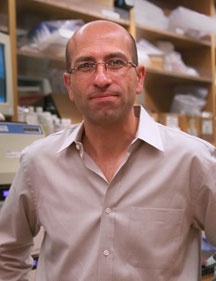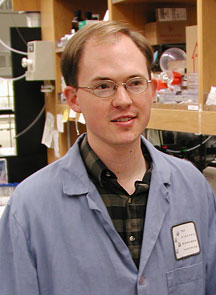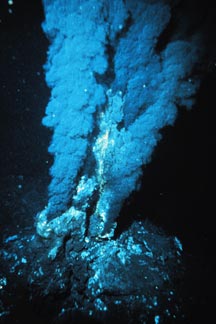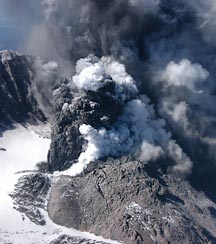

Study Suggests Component of Volcanic Gas May Have Played a Significant Role in the Origins of Life on Earth
Carbonyl Sulfide Forms Peptide Bonds
By Jason Socrates Bardi
Scientists at The Scripps Research Institute and the Salk Institute for Biological Studies are reporting a possible answer to a longstanding question in research on the origins of life on Earth—how did the first amino acids form the first peptides?
Peptides and proteins are strings of amino acid building blocks, and they are one of the most important classes of biological molecules found in living things today. Fifty years of chemical research on the origins of life has shown that amino acids could have formed spontaneously on the early Earth environment or could have been introduced onto the early Earth from meteorites.
"There are lots of ways to make amino acids," says Professor M. Reza Ghadiri, who is a member of The Skaggs Institute for Chemical Biology at Scripps Research. "But the question is, how do you couple them together?"
Ghadiri and Luke Leman, who is a member of the Kellogg School of Science and Technology at Scripps Research, worked out one possible solution with Leslie Orgel of the Salk Institute. In the latest issue of the journal Science, Leman, Ghadiri, and Orgel suggest that the missing link is a chemical component of volcanic gas known as carbonyl sulfide.
Carbonyl sulfide is present in volcanic gasses and deep sea vent emissions today, and since these geological phenomena were prominent features on the early Earth, it is reasonable to assume that the gas was present.
In their report, the scientists demonstrate that the gas can bring about a vigorous chemical reaction that forms peptides under mild aqueous conditions. Within a few minutes of introducing the gas to a reaction vessel containing amino acids, they observed high yields of di-, tri-, and tetra-peptides. They carried out the reaction in the presence of air, without air, and with and without other ingredients like metal ions, and they found peptides formed readily under all these conditions.
"It's really efficient, actually," says Ghadiri. "This addresses a very important question that we did not have a real good answer for."
Life—What We Know, and What We Don't
The question of how life originated is one of the most interesting gaps in our knowledge—interesting perhaps because we know approximately when it occurred, but we do not know how it occurred.
The earliest fossils scientists have found are stromatolites—large clumps of cyanobacteria that grew in abundance in the ancient world over 3.5 billion years ago in what is now western Australia. These most likely evolved from some simpler life forms because, like all modern life, cyanobacteria are highly sophisticated living organisms—with cell walls, complex metabolism, and DNA genes. The question of the origins of life is: what came before the stromatolites?
Research on the origins of life has suggested the notion of an ancient RNA world—one in which RNA genes stored genetic information (something done by DNA today), carried out the chemistry necessary for life, and formed the essential physical structures of life (something done primarily by proteins today).
But how did that RNA world come about?
"Anybody who thinks they know the solution to this problem [of the origin of life] is deluded," says Orgel.
"But," he adds, "anybody who thinks this is an insoluble problem is also deluded."
One possible approach to the problem of life's origins is to ask the question scientifically rather than historically— how can life emerge rather than how did life emerge. In order to address this, scientists try to determine experimentally what is chemically feasible and what could have occurred on the prebiotic earth.
One possibility, which was suggested in the 1920s by the Russian scientist A.I. Oparin, is that life emerged in its most primitive forms from minerals, metals, and the elements carbon, hydrogen, oxygen, and nitrogen, which were combined into amino acids, nucleotides, and the other the building blocks of life under the violent energy of lightning, solar radiation, comet impacts, and volcanic events that were present.
In 1953, this theory was given a boost when a paper was published in Science by Stanley L. Miller, who is Professor Emeritus at the University of California, San Diego. In the paper, Miller described an experiment he devised with Harold C. Urey—now called the Miller and Urey experimen—that gave experimental underpinnings to Oparin's ideas.
In the experiment, Miller boiled H2O, CH4,H2, and NH3 gases in a glass apparatus containing a pair of tungsten electrodes. He subjected the chemicals to an electric discharge, intended to simulate conditions on the early Earth, and he collected and analyzed the molecules that formed—which included the amino acids alanine, glycine, and a few others. In the years since, several other investigators have expanded on the Miller–Urey experiment to demonstrate the formation and chemistry of many of the common biological amino acids, sugars, and nucleotides. Orgel, who is a long-time investigator in the field, has done pioneering research on the prebiotic chemistry of nucleotides.
This latest study is an advance because previous attempts to demonstrate the formation of peptides on early Earth depended on reaction schemes that were less plausible or were not as efficient. Next, the team plans to examine carbonyl sulfide's reactive properties further and see if the gas can bring about other chemical reactions that are relevant to prebiotic chemistry.
The article, "Carbonyl Sulfide–Mediated Prebiotic Formation of Peptides" by Luke Leman, Leslie Orgel, and M. Reza Ghadiri and appears in the October 8, 2004 issue of the journal Science. See: http://www.sciencemag.org.
This research was supported by The Skaggs Institute for Research, by the NASA Astrobiology Institute, by NASA Exobiology, and through a National Science Foundation Predoctoral Fellowship.
Send comments to: jasonb@scripps.edu

"This [study] addresses a very important question that we did not have a real good answer for," says Professor Reza Ghadiri.

Luke Leman, a member of the Kellogg School of Science and Technology at Scripps Research, is lead author of the October 8, 2004 paper in the journal Science.

"Anybody who thinks they know the solution to this problem [of the origin of life] is deluded," says Leslie Orgel, "but anybody who thinks this is an insoluble problem is also deluded.


Carbonyl sulfide may have been essential for making peptides in the prebiotic world, say Ghadiri, Leman, and Orgel. Sources of carbonyl sulfide include hydrothermal vents, such as this mid-Atlantic ocean ridge black smoker (top), and volcanic emissions, such as this plume erupting from Mount St. Helens last week (bottom). Vent image by P. Rona, courtesy of OAR/NURP/NOAA. Volcano image by John Pallister, courtesy of the U. S. Geological Survey.
